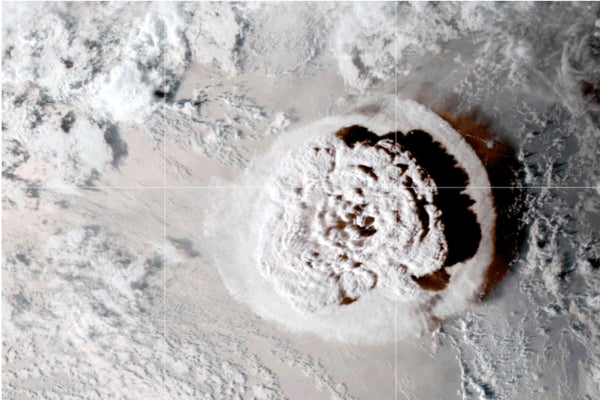CLIMATEWIRE | Scientists around the world are exploring the climate impacts of what appears to be one of the largest and farthest reaching volcanic eruptions in history. It began rumbling in late December 2021 and culminated in a towering plume rising over two tiny, uninhabited islands in the South Pacific called Hunga Tonga and Hunga Ha'apai.
What made this eruption special was its location and its power — it came from an underwater volcano that exploded with the force of a large nuclear weapon Jan. 13, 2022, and again Jan. 15, 2022. According to a recent report by NOAA, the eruptions launched a record slug of seawater — an estimated 150 million tons of it. Some of it even reached the stratosphere.
The force behind the eruptions, the unusual presence of water in the plume and the plume's continued movement around the globe have caught the attention of researchers worldwide. NOAA scientists say the eruptions have spawned dozens of new studies about climate change.
On supporting science journalism
If you're enjoying this article, consider supporting our award-winning journalism by subscribing. By purchasing a subscription you are helping to ensure the future of impactful stories about the discoveries and ideas shaping our world today.
One question they're trying to answer is whether the chemical mix in the eruptions could inflict more damage to the Earth’s protective ozone layer, an atmospheric shield that blocks the harmful ultraviolet rays of sunlight. For instance, chlorine in the giant plume might react with water and partially degrade the ozone layer. And in theory, water vapor expelled by the eruptions can be a greenhouse gas.
The plume may also help determine whether it’s possible — as some scientists predict — to geoengineer clouds of sulfur dioxide, a gas contained in the plume, that might shade parts of the Earth from global warming. Currently, scientists can only generate a relatively small cloud of sulfur dioxide, but studying the impacts of a much larger cloud may help answer the question of whether the approach can help decrease temperatures by reflecting sunlight back into space.
“This is like a huge validation test of our climate models,” said Karen Rosenlof, a senior scientist at NOAA’s Chemical Sciences Laboratory, speaking broadly about the eruption. She was alerted to the eruption in time to get a collection of U.S. scientists and newly invented portable instruments to a French island called Reunion in the Indian Ocean.
Reunion is 8,000 miles to the west of the eruptions, but as she explained in an interview, the team arrived ready to launch weather balloons carrying instruments that helped them measure the contents of the unusual plume as it drifted overhead — pushed westward by winds from Hunga Tonga.
The questions raised by the eruption “have brought together a lot of people world-wide to try and study and analyze all of this,” Rosenlof said.
One study she co-authored with a team of scientists showed that the plume developed three times faster than under normal stratospheric conditions and carried “an unexpected abundance of large particles” — but not as much sulfur as expected. The sulfur, even at lower levels, still can help inform geoengineering research because of the size of the plume.
Another study she helped write concluded that the “plume created ideal conditions for swift ozone depletion,” which may help researchers learn more about gaps in the ozone layer and how they developed, such as one scientists have found over the South Pole.
More studies are coming, including one mandated by the Montreal Protocol that's due in 2026. The international agreement calls for periodic testing of emissions that can cause harm in the stratosphere, and it could pick up more data from the eruptions.
According to NASA, Hunga Tonga was the largest underwater explosion ever recorded, and the blast likely will not be repeated anytime soon, in large part because the volcano was under 490 feet of water. If it were shallower, it would have spread less water. If it were deeper, “the immense pressures in the ocean’s depths could have muted the eruption.”
Reprinted from E&E News with permission from POLITICO, LLC. Copyright 2023. E&E News provides essential news for energy and environment professionals.
